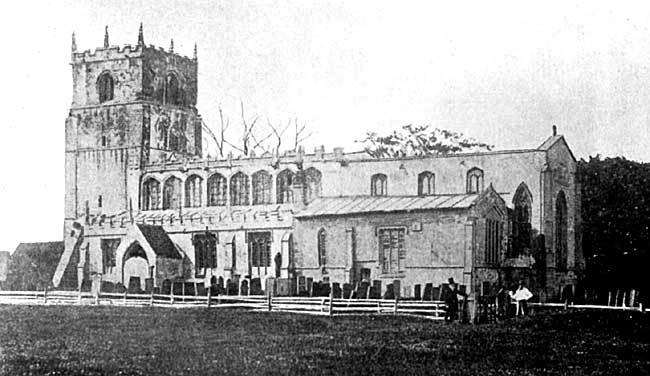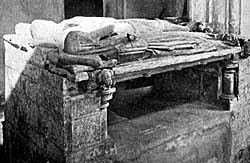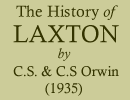III. THE CHURCH AND THE CLERGY

Laxton church prior to its restoration.
WHEN the first church was built at Laxton cannot now be determined. There is no mention of one in the Domesday Survey, but reference to the church has been found in the twelfth century, when Ralph Alselin and Robert de Caux founded a priory for Austin Canons, at Shelford, in the reign of Henry II, and part of its endowment was the church at Laxton. As the first Prior was instituted in 1204, the church must have been built before that date.
The present building is dedicated to St. Michael the Archangel, and the oldest portion is the nave arcade. Its flattened arches and cylindrical piers with their bases of the 'water-holding' type, are transitional between the Norman and the Early English periods, say about 1190. There is evidence that a tower was built at the west end in 1339.
About the year 1250 the earlier chancel and aisles were rebuilt, the occasion being the founding of a chantry to the Blessed Virgin Mary by Sir John de Lexington, who endowed it and vested it in the Prior of Rufford. A chantry was an endowment for the celebration of masses at an altar in a church for the souls of the departed. Usually masses were said by a specially appointed priest who held his chantry as an independent benefice, and his altar, his stipend, and his house, if one were provided, were as fully his freehold as the church and rectory were of the rector. The father, mother, and sister of Sir John de Lexington were buried in the north aisle of the church, and it was here that his altar to the Virgin was set up. The endowment of the chantry amounted to 5 marks yearly, from rents.
The family of Lexington founded and endowed another chantry at Laxton, dedicated to St. Edmund, though there is no record of a chapel or altar connected with it. This chantry was a donative, and the two chantry priests shared a house which was still standing near the eastern end of the church in 1635. Lands for their support were set aside in the Laxton fields.
The present chancel is mostly fourteenth-century work, and the tall two-light windows in the north and south walls are beautiful examples of the Decorated period. On the north wall are the remains of an Easter sepulchre, and opposite to this, on the south wall, is a 'low-side' window, commanding a view both of the High Altar and Easter Sepulchre. Adjoining this window is a double piscina and a triple sedilia surmounted by richly carved ogee heads. Beneath the cornice of the sedilia on the west is a very rare relic of the pre-Reformation custom of veiling the altar in Holy Week. It is a pulley, on which ran a cord carrying a curtain which was erected before the first Sunday in Lent and drawn aside whenever the Gospel was being read, until the Thursday before Easter,when it was lowered during the reading of the words 'the vail of the Temple was rent in twain'.
Towards the end of the fifteenth century the advowson of the church had passed to Thomas Rotherham, Archbishop of York, and the present clerestory and the roof of the nave were built by him. The chancel screen, too, as it now stands, is made up of fragments of the rood screen erected at the same time. An effigy of Archbishop Rotherham in mitre and cope, with three stags (his coat of arms) at his feet, forms a panel in the battlements outside. The angel brackets supporting the roof inside and the grotesque ornaments of the battlements are noteworthy.
In the north aisle there is a portion of a beautiful screen inscribed with the name and date of the donor, Robert de Trafford, Vicar of Laxton, 1532. It bears a small shield upon which are carved the Five Wounds. The arms of Roos may be seen upon the central beam of the roof, and outside, on the chancel end, are those of Bekering and de Longvilliers.
Like many other fine churches, Laxton Church passed through a long period of neglect and decay in the eighteenth century. Thoroton has left a vivid picture of it at this time, the fine monuments of the Lords of the Manor thrown into the churchyard and the building itself littered with rubbish. In 1861 the work of restoration was undertaken by the second Earl Manvers. The Early English tower was taken down, together with the last bay of the nave, and the present tower was erected out of the old materials, at the end of the nave thus shortened. The effect was to destroy the proportions of the church, chancel and nave being now out of balance and the length of the two insufficient to carry the width. An attempt was made to correct this by pulling down the north aisle and the Lexington chapel and the south aisle, replacing them with the present narrower structures. The south porch was taken down and rebuilt at the same time.

Adam de Everingham and his wives.
There is now no stained glass remaining in the church, but there are a few monuments of great interest. In the north aisle is a tomb much mutilated, the details of which suggest the latter part of the thirteenth century. The north aisle was the chapel of the Lexingtons, the inferior lords of Laxton, and it is probable that this tomb was built by a member of this family. At some date the tomb has been cut down to form a resting-place for the statues of the second Adam de Everingham (d. 1341) and his two wives. Two of these figures are in stone, white limestone from Aubigny, the work of the same sculptor. They represent the knight and his first lady, Clarice, and appear to have been carved at the same time, probably at her death. There is a shield bearing the lion rampant of the Everinghams. The third figure is an example of a sepulchral monument almost unique in this country. It is an effigy in oak of Margery, Adam's second wife.
In the south aisle lie three figures without tombs. The oldest is that in the middle, carved of yellow Mansfield limestone which may have been painted, and the ring armour and costume suggest that it may represent Robert de Everingham, who died in 1287. The second figure is also that of a knight, perhaps the third Adam de Everingham who died in 1387, in elaborate costume and armour, consisting of ring mail on the head, neck, and body, with plate armour on shoulders, elbows, and legs.
Lying on the floor against these two is a headless trunk, in alabaster, which was formerly on a raised tomb in the south chapel. The figure is in armour with its helm for a pillow, and it probably represents Reginald, the last of the Everinghams, who died in 1398.
Robert de Lexington is the first recorded Rector of Laxton, the Prior and Convent of Shelford being the patrons, and on 25 January 1240 he appointed Richard de Nottingham to be Vicar.
Towards the end of the century the patronage had passed to the Everingham family, and it descended with the lordship of the manor until the end of the fifteenth century, when the Roos family gave it to the Archbishop of York, together with the rectorial tithes, for the endowment of his newly founded College of Jesus, at Rotherham. From this date Laxton ceased to have a clerical rector.
The Provost and College of Rotherham presented vicars until the dissolution of the religious houses, when the advowson and its emoluments passed to the Crown and Queen Elizabeth and King James I, in turn, presented to the Vicarage. Early in the seventeenth century, however, it was acquired by the Pierrepoint family, in whose gift the living remains to this day.
